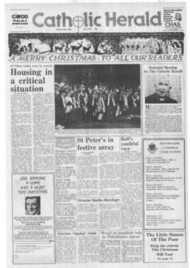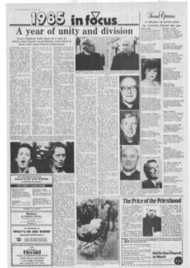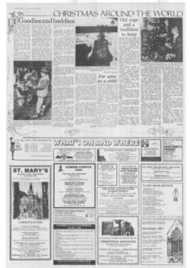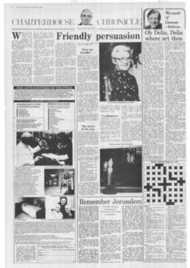Page 4, 20th December 1985
Page 4

Report an error
Noticed an error on this page?If you've noticed an error in this article please click here to report it.
Tags
Share
Related articles
Breaches In The Anglican Walls
Another Oxford Movement
Bishops Stand By Vatican Ii
Breaking Bread For United Marriage
Trentine Dogma On Arcic Agenda
A year of unity and division
Kasia Giedroyc looks back on a year in which inter-Church reconciliation went hand in hand with inner-Church disharmony
AN HISTORIC moment in the life of the Catholic Church and a milestone on the road to Church Unity made headlines in May when, after a lengthy process of consultation, the Final Report of the First Anglican/Roman Catholic Commission (ARCIC I) got the episcopal Thumbs Up.
In a slim grey volume, reminiscent of a dialling code book, the Catholic Bishops of England and Wales praised the outstanding achievements of ARCIC I, pledged their support for the Commission's future work, and gave clear indications ,of the areas where more work was needed.
It was a superb document: straightforward, brief and honest.
Although the Bishops considered that much of the Final Report affirmed the faith of the Catholic Church, they were not shy in suggesting parts that were "inadequate in treatment or expression". Although they acknowledged that "in our understanding of the Word of God, differing theological expressions often can be complementary", they stressed their concern "to ensure that the relationship of authoritative formulae to the truths they seek to convey should not be weakened".
But Bishop Francis Thomas of Northampton, Chairman of the Theology Commission which prepared the response, emphasised that the Bishops' reservations should not be interpreted as rejections but as pointers for future discussion.
111 its Final Report, the Commission of Anglican and Catholic theologians had claimed "substantial agreement" on the first two subjects of the Eucharist and Ministry.
The English and Welsh Bishops endorsed that claim but they drew attention to specific isues requiring further study such as the question of reservation and adoration of the Eucharist, and indicated the problems created by the ordination of women in some parts of the Anglican Communion.
They suggested that the question of "who can or cannot be ordained" could not be separated as easily as ARCIC I appeared to think from "the origin and nature of the ordained ministry". In other words, the way in which the ministerial priesthood was instituted by Christ, and its nature, are vital to the issue of women priests.
The Bishops also found themselves in agreement with ARCIC on the vexed question of Anglican orders, saying that the issue should he explored in the context of developments in both Catholic and Anglican thinking on the nature of the Church and the ordained ministry. They wondered whether this might lead to a resolution of the present situation by "an agreed act of convalidation or reconciliation".
The progress made by ARCIC I on the question of Authority in the Church was hailed as outstanding, although the Commission did not claim to have reached substantial agreement; there was disagreement on the nature of a universal primacy and its jurisdiction. Nevertheless, the Bishops saw grounds here for substantial agreement in the future.
Significantly, their suggestions for the future deliberations of ARCIC underlined the need for "the Anglican evangelical voice to be heard to greater effect".
This echoed the fears expressed by some people that the agreements of ARCIC I could not be accepted by a substantial number of Anglicans.
And sure enough the Church of England's main evangelical organisation, the Church Society, the following month launched a national campaign urging members of the deanery
and diocesan synods to reject the Final Report even though the 1984 General Synod had already approved it.
So the quest for unity had, it seemed, forced a split in the Church of England. Reconciliation in one direction had, ironically, brought division in another.
Moreover, to the considerable (but large unpublished) dismay of the Anglican authorities, 1985 saw a growing number of leading Church of England clergymen taking the cause of unity into their own hands by seeking entry into the Catholic Church.
Most prominently among these were the Vicar of the University Church of St Mary the Virgin, Oxford, the Rev Peter Cornwell, and the chaplain of Lincoln College, Oxford, the Rev Ralph Townsend.
Both of them, in announcing their move, reflected the conclusions of ARCIC I that the mainstream of Christianity is that body of Christians in communion with the Bishop of Rome. They came to see their separation from this body as something divisive, not productive, and therefore not of service to Christianity.
The Rev Cornwell and the Rev Townsend also referred to the lack in the Church of England of a coherent doctrinal authority based on the grace of faith rather than on the innovation of "scholars".
Anglicans who feel close to Rome were clearly not the only members of the Church of England who sensed this lack. The evangelical wing was equally worried. by the views associated with Dr David Jenkins, the Anglican Bishop of Durham, and the Church's method of dealing with them.
A further cause of Anglican division this year was the question of women priests. In October, the Anglican Bishop of London, Dr Graham Leonard, a convinced opponent, warned that the battle over the ordination of women would split the Church of England into two parts. He offered to play a leading role in the breakaway body.
The fight to ordain women has won vigorous support within the Church of England even though the most optimistic spokesmen for the ecumenical movement say that ARCIC is finished if the new General Synod eventually votes in favour of women priests.
The Catholic Church had its share of division this year. As the letters page of the Catholic Herald witnessed every week, Catholics continued to take different standpoints on the nuclear question, the role of women in the Church and developments in the liturgy.
But nothing caused more headed argument — or more confusion — than the outcome of a Catholic mother's five-year campaign to prevent doctors from prescribing contraceptives to girls under 16 without their parents' consent.
The Gillick case caused confusion both inside and outside the Church because the way in which it was reported suggested that the Bishops had failed to support Catholic teaching on moral issues associated with the affair.
The turmoil began three days before the Lords' October 17 judgment, when Mrs Gillick publicly attacked the hierarchy for failing to lend proper support to her fight.
This formidable mother of ten, with a remarkably good eye for publicity, had distributed her speech in advance to all the national newspapers. It made front-page news.
The ensuing response from the Catholic Media Office rejecting Mrs Gillick's statements as "simply at variance with the facts" got no further than the religious press.
When it became clear that the DHSS had won, Cardinal Basil Hume issued a statement emphasising that legal decisions had no effect on Church teaching, which rules out the use of artificial means of contraception.
But hot on the heels of the cardinal's response came a front-page article in the Guardian headlined: "Catholic hierarchy backs Lords on Pill". So Cardinal Hume issued yet another statement, this time repudiating the Guardian article which, he said, "could seriously mislead on the reaction of the Catholic Bishops to the Lords' judgment".
He stressed that the Catholic moral position is unaffected by the Lords' decision and explained why the Bishops, while backing Mrs Gillick's affirmation of moral principle as well as her concerns as a Christian parent, were not convinced of the wisdom of taking legal action which raised other complex issues, for example the legal limits of parental responsibility, how to protect children of irresponsible or problem parents, and how to defend medical confidentiality.
An important aspect of the whole affair was Mrs Gillick's focus on parental rights. Whilst the Bishops argued that the complicated issues involved in the Gillick case could not be solved by the simple assertion of parental rights as infallible, Mrs Gillick's supporters countered that all law has a formative effect, and that if something is legally allowed, sooner or later it is also seen as morally acceptable. They felt that the distinction between private morality and public law is a dangerously misleading one.
Reluctantly, though, they had to settle for the relatively strict conditions under which doctors are now allowed to prescribe contraceptives to under-age girls, without their parents consent.
Despite concerted attempts by journalists to drum up some newsworthy divisions in the Church over the Extraordinary Synod, the mood of confidence and co-operation prevailed.
As their official contribution to the process of preparation for the Synod which met in extraordinary session this winter, the Bishops of England and Wales published a document making it clear that they looked to the Rome meeting for a positive reaffirmation of the spirit and decrees of Vatican II.
Their expectations echoed the responses to the consultations held in the dioceses earlier in the year. Expressed by moderate Catholics at the "centre" of the Church, these showed a widespread acceptance of the Council and the changes it brought about, as well as an awareness that more needs to be done to fulfil its promise.
Some viewed the document as an open challenge to Vatican officials who believed that the decrees of Vatican 11 had been falsely implemented, but the Secretary of the Bishops' Conference, Mgr Vincent Nichols, told journalists that the submission "was not designed for conflict".
It was reconciliation, not conflict, that permeated the Bishops' document, added Mgr Nichols. "The work of international commissions such as ARCIC and LIMA have given rise to expectations of further ecumenical progress. Therefore account must be taken of this in any presentation of the mission of the Church in our time".
On his return from Rome earlier this month, Cardinal Hume spoke of the great significance for progress in Christian unity of the Bishops' affirmation of the concept of the Church as communio.
"We know from experience that the concept of communio has helped our search for Christian unity, especially in dialogue with the Anglican Communion", said the cardinal. "The Synod recognised that ecumenism is not only a high priority of the Church but must influence every aspect of its life and mission. The real but imperfect communio which already exists in virtue of a common baptism has still to be brought to the fulfilment for which Christ prayed".
The cardinal said it was important to understand unity among Christians as "a gift which is being given to us by God. It is a growing together, admittedly slow and, at times, difficult, but I believe that the way the Synod thought and spoke about the Church will make it possible for our separated brethren to see the need for Peter as necessary for unity of faith and charity".
Cardinal .Hume went on to point out that the Extraordinary Synod had provided the right theological context in which to prepare for the Synod on the Laity. "Already in England and Wales through Called to Serve and the National Forum, the Bishops have begun to consult the laity in their preparation for the next Synod.
"So the process continues of absorbing the true meaning of the Council and of putting it into practice".
ARC 1C I and the Extraordinary Synod may lie behind them but the Bishops of England and Wales cannot expect next year to be any less challenging than the last. ARCIC 11 and the Synod on the Laity lie ahead and the problems in secular society (those highlighted by the Gillick case and many, many more) lie all around.
blog comments powered by Disqus











